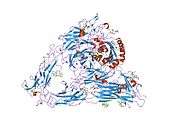ITGAV
| View/Edit Human | View/Edit Mouse |
Integrin alpha-V is a protein that in humans is encoded by the ITGAV gene.[3]
ITAGV encodes integrin alpha chain V. Integrins are heterodimeric integral membrane proteins composed of an alpha chain and a beta chain. Alpha V undergoes post-translational cleavage to yield disulfide-linked heavy and light chains, that combine with multiple integrin beta chains to form different integrins. Among the known associating beta chains (beta chains 1,3,5,6, and 8; 'ITGB1', 'ITGB3', 'ITGB5', 'ITGB6', and 'ITGB8'), each can interact with extracellular matrix ligands; the alpha V beta 3 integrin, perhaps the most studied of these, is referred to as the Vitronectin receptor (VNR). In addition to adhesion, many integrins are known to facilitate signal transduction.[4]
Alpha V class integrins
In mammals the integrins that include alpha-V are :
| Name | Synonyms | Distribution | Ligands |
| αVβ1 | ocular melanoma; neurological tumors | vitronectin; fibrinogen | |
| αVβ3 | vitronectin receptor[5] | activated endothelial cells, melanoma, glioblastoma | vitronectin,[5] fibronectin, fibrinogen, osteopontin, Cyr61 |
| αVβ5 | widespread, esp. fibroblasts, epithelial cells | vitronectin and adenovirus | |
| αVβ6 | proliferating epithelia, esp. lung and mammary gland | fibronectin; TGFβ1+3 | |
| αVβ8 | neural tissue; peripheral nerve | fibronectin; TGFβ1+3 |
As a drug target
The mAbs intetumumab, and abituzumab target this protein which is found on some tumour cells.[6]
See also
References
- ↑ "Human PubMed Reference:".
- ↑ "Mouse PubMed Reference:".
- ↑ Sosnoski DM, Emanuel BS, Hawkins AL, van Tuinen P, Ledbetter DH, Nussbaum RL, Kaos FT, Schwartz E, Phillips D, Bennett JS, et al. (Aug 1988). "Chromosomal localization of the genes for the vitronectin and fibronectin receptors alpha subunits and for platelet glycoproteins IIb and IIIa". J Clin Invest. 81 (6): 1993–8. doi:10.1172/JCI113548. PMC 442653
 . PMID 2454952.
. PMID 2454952. - ↑ "Entrez Gene: ITGAV integrin, alpha V (vitronectin receptor, alpha polypeptide, antigen CD51)".
- 1 2 Hermann P, Armant M, Brown E, Rubio M, Ishihara H, Ulrich D, Caspary RG, Lindberg FP, Armitage R, Maliszewski C, Delespesse G, Sarfati M (February 1999). "The vitronectin receptor and its associated CD47 molecule mediates proinflammatory cytokine synthesis in human monocytes by interaction with soluble CD23". J. Cell Biol. 144 (4): 767–75. doi:10.1083/jcb.144.4.767. PMC 2132927
 . PMID 10037797.
. PMID 10037797. - ↑ Élez, E.; Kocáková, I.; Höhler, T.; Martens, U. M.; Bokemeyer, C.; Van Cutsem, E.; Melichar, B.; Smakal, M.; Csőszi, T.; Topuzov, E.; Orlova, R.; Tjulandin, S.; Rivera, F.; Straub, J.; Bruns, R.; Quaratino, S.; Tabernero, J. (2015). "Abituzumab combined with cetuximab plus irinotecan versus cetuximab plus irinotecan alone for patients withKRASwild-type metastatic colorectal cancer: the randomised phase I/II POSEIDON trial". Annals of Oncology. 26 (1): 132–140. doi:10.1093/annonc/mdu474. ISSN 0923-7534.
Further reading
- Horton MA (1997). "The alpha v beta 3 integrin "vitronectin receptor".". Int. J. Biochem. Cell Biol. 29 (5): 721–5. doi:10.1016/S1357-2725(96)00155-0. PMID 9251239.
- Porter JC, Hogg N (1999). "Integrins take partners: cross-talk between integrins and other membrane receptors.". Trends Cell Biol. 8 (10): 390–6. doi:10.1016/S0962-8924(98)01344-0. PMID 9789327.
- Sajid M, Stouffer GA (2002). "The role of alpha(v)beta3 integrins in vascular healing.". Thromb. Haemost. 87 (2): 187–93. PMID 11858476.
- Cooper CR, Chay CH, Pienta KJ (2002). "The role of alpha(v)beta(3) in prostate cancer progression.". Neoplasia. 4 (3): 191–4. doi:10.1038/sj/neo/7900224. PMC 1531692
 . PMID 11988838.
. PMID 11988838. - Cacciari B, Spalluto G (2005). "Non peptidic alphavbeta3 antagonists: recent developments.". Curr. Med. Chem. 12 (1): 51–70. doi:10.2174/0929867053363522. PMID 15638730.
- University of Edinburgh. (2013, November 10). Hope for transplant patients as study finds key to organ scarring. ScienceDaily. Retrieved December 2, 2014 from www.sciencedaily.com/releases/2013/11/131110184408.htm
External links
- CD51 Antigen at the US National Library of Medicine Medical Subject Headings (MeSH)
- ITGAV Info with links in the Cell Migration Gateway




